The 5 Differences Between Leopard Gecko and Crested Gecko
Are you a parent looking for a birthday gift to your pubescent teen? Or a young adult searching for a companion in your flat? Leopard and crested geckos are equally popular reptile recommendations by pet-lovers for beginners. But of the two, which should you get?
Though both are species of geckos with a similar level of care as pets, leopard and crested geckos have five considerable differences to take into account:
- habitat
- appearance
- behaviour
- housing
- diet
Read on as we dig deeper into their differences.
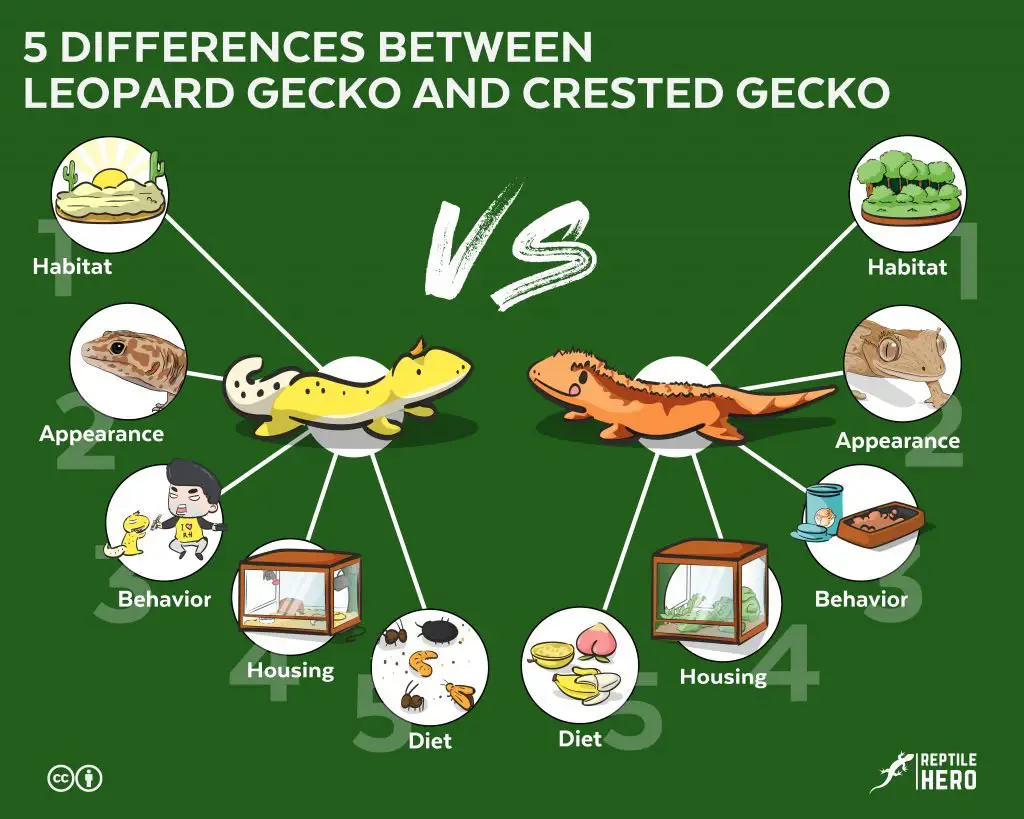
Leopard vs Crested: Which fits you best?
Although there are over a thousand geckos species worldwide, humans have only bred a few like leopards and cresteds for captivity. Despite both being forgiving pets for beginners, owning either of the reptiles entails varying levels of care. To help you assess choosing the one that fits you best, you should read these five category differences.
Habitat Differences
After decades of domestication by captive-breeding, both leopard and crested geckos are still present in the wild like any exotic pets.
Leopard Gecko (Eublepharis macularius)
Origin: Southern Asia
Habitat Region: Desert
Leopard geckos (leos) live in the rocky, dry grassland and desert areas of Southern Asia. In the wild during the day, they favor burrowing under the ground or hide under rock crevices from the sun’s intense heat. From dusk until dawn, they are most active since the temperature is more favorable.
Crested Gecko (Correlophus ciliatus / Rhacodactylus ciliatus)
Origin: New Caledonia
Habitat Region: Tropical
Crested geckos (cresties) live in trees in the forests of New Caledonia. They spend daytime relaxing on lush vegetation under the forest floor in the wild, where it is less sunny and less warm. At night, they expend their energy hunting for bugs in shrubs and lower portions of the canopy.
Physical Differences
Visiting any pet shop with reptiles, seeing both leopard and crested geckos is an assurance. With both having unique physical characteristics than other gecko species, falling in love with either of the two is my guarantee to you.
Appearance
As their name suggests, leopard-like spots characterised by thick horizontal bands prominently cover the bumpy skin at the back of leos. Underneath their rough bodies is a smooth underbelly. Some, however, lack the distinguishing marks.
On the other hand, cresties have distinct structural crest abundance, which sets them apart. The crests’ size and coverage may vary; some have extended ridges covering the head to the tail while others lack one side of the body.
Colour
In the wild, leos have dark, dull, and neutral colourations. Though this may sound uninteresting to you, these features help them camouflage their surroundings to hide from potential predators.
However, in captivity, they generally have diverse skin colours and patterns that are more appealing to prospective pet owners like you. As a result of selective breeding, different morphs have evolved.
For instance, a famous albino variation exists, which lacks yellow and brown pigments. Aside from this, you can also choose from other available morphs:
- tangerine
- patternless
- carrot-topped
- carrot-tailed
- blizzard
- jungle
- giant
- supergiant
In the wild, cresties exist in three colour morphs: patternless, tiger, and white-fringed.
- Patternless cresties tend to have a more or less solid color from bright yellow, green, and red to muted brown and grey. Though originally patternless, some have very faint patterns present on their backs;
- Tiger cresties resemble the deep, dark, contrasting stripes of a tiger on their light-colored skin. These stripes also extend on their belly;
- White-fringed cresties are differentiated from other morphs by their white or yellow coloration on all or a portion of their calcified crests.
In captivity, they also come in these three patterns. However, if you do not like these morphs, you need not worry. Many alterations in their skin colour are exclusively common in captive-bred individuals.
Eyes
Leos have eyes that are very sensitive to light that you must be aware of as an owner. By evolution, they adapted to seeing even in the darkest of conditions.
However, one thing unusual to them that you will not encounter in other species is their moveable eyelids which close!
Cresties, on the other hand, do not have eyelids. Hence, do not panic if you will not see them blink at all!
To compensate for this, they use their long tongues to moisten their eyes. By doing so, they also remove debris and foreign matters which can irritate.
Legs
Leos have four limbs with toe pads that lack the sticky feature common to other gecko species. As a result, you may observe them unable to climb walls and live on the ground with their clawed toes.
Cresties also have four limbs. However, underneath their toe pads are a network of hairs that enable them to walk on very smooth vertical surfaces. Hence, you may see them on treetops or walls of your tank.
Other Differences
A summary of other physical differences worth mentioning between leos and cresties are in the table below.
| Differences | Leopard Gecko | Crested Gecko |
|---|---|---|
| Average adult size, inches | 6 – 9 | 5 – 8 |
| Average adult weight, grams | 50 – 80 | 30 – 35 |
| Lifespan in captivity, years | 20 + | 5 + |
Behavioural Differences
Similar to humans, both leos and cresties exhibit general behaviours that are specific to them. As a soon-to-be reptile parent, it is essential to know which of the two suits your personality best so that you and your pet can cohabit peacefully.
Leopard Gecko
If you are the laid-back type, leos might be for you. They tend to have a gentler disposition to the point that you may perceive them as dull and clumsy compared to cresties.
When inside the tank, they seem to be more interested in their surroundings. They enjoy exploring and paying close attention to the environment at night when they are most active at their own slow pace.
Moreover, handling is not a big issue unless you somehow run into the fidgety, nervous, or flighty younger ones. They even tend to just sort of sit on your hand when you properly take them.
However, take note to keep handling to a minimum as overhandling can cause them stress. It would also be best if you never grabbed by the tail or else they may drop it.
A remarkable behaviour you might like about them is that they are fastidiously clean. They tend to exclusively pick a one-bathroom spot, which makes tank maintenance less demanding.
Crested Gecko
Cresties, on the other hand, fits you best if you are the active type. They tend to have a more energetic temperament compared to leos.
When inside the tank, they seem to move a lot at night. They jump around and climb the walls though they space-out a lot as well, staring at you blankly.
Furthermore, handling them is simple when they are used to you. However, it would help if you never grabbed by their tail. Once dropped, it will never grow again!
Although they seem sweeter and more friendly, they may bite you and can grip your fingers. Luckily, they lack the jaw and limb power to do any real damage on your skin.
Unusual behaviour that may attract you to them is that they are trainable. You can leave their food in a bowl and not worry about hand-feeding all the time.
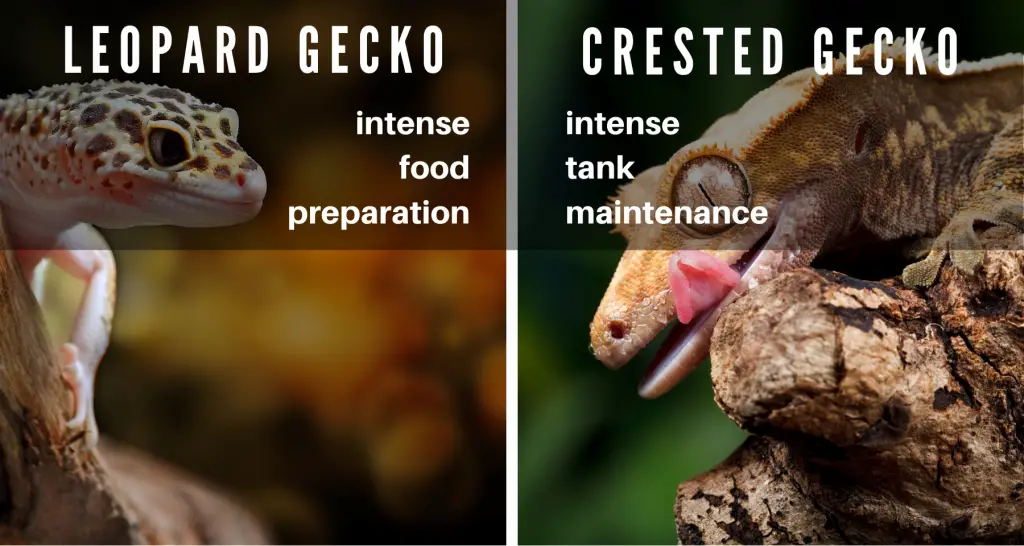
Housing Differences
You might have guessed it right: both species are opposite ends of the spectrum regarding the environment. Since both leos and cresties have different habitats in the wild, this means mimicking different setups when housing them in captivity. To guide you quickly with the distinctions, here is a table presented below.
| Set up | Leopard Gecko | Crested Gecko |
|---|---|---|
| Tank Size | 20-gallon tank | 20-gallon tank |
| Tank Orientation | floor space is more important than height | height is more important than floor space |
| Habitat | must have a lot of hiding areas under branches, corks, logs around the tank | must have a lot of climbing spots like branches and hiding areas for shelter like non-toxic plants |
| Substrate | must use a combination of paper towel, rough, flat slate pieces, and terrarium carpet | must use a variety of coconut bedding, dampened sphagnum moss and organic soil mix |
| Temperature | must have a basking area with a temperature at 95°F and a cool-end place with a temperature between 78 and 88°F | must have a daytime temperature between 75° and 82°F and a nighttime temperature between 68° and 75°F |
| Humidity | must maintain humidity below 50% | must maintain 60 to 80% humidity by misting as needed every day. |
| Lighting | must provide 10 to 12 hours of light per day is required | must provide light 10 to 12 hours a day |
Dietary Differences
Coming from different wild environments, you should expect that both leos and cresties have opposing food choices. Presented in a table are their food preferences you cannot merely interchange.
| Difference | Leopard Gecko | Crested Gecko |
|---|---|---|
| Classification | carnivore (specifically insectivore) | omnivore |
| Food | live insects, including crickets, small mealworms and waxworms, dubia roaches | commercial crested gecko food, a variety of insects, and mashed up fruits and vegetables |
| Water | fresh, clean, chlorine-free water | fresh, clean, chlorine-free water |
| Supplements | calcium supplement daily and a multivitamin supplement once or twice a week | calcium supplement at each feeding and a multivitamin supplement once or twice a week |
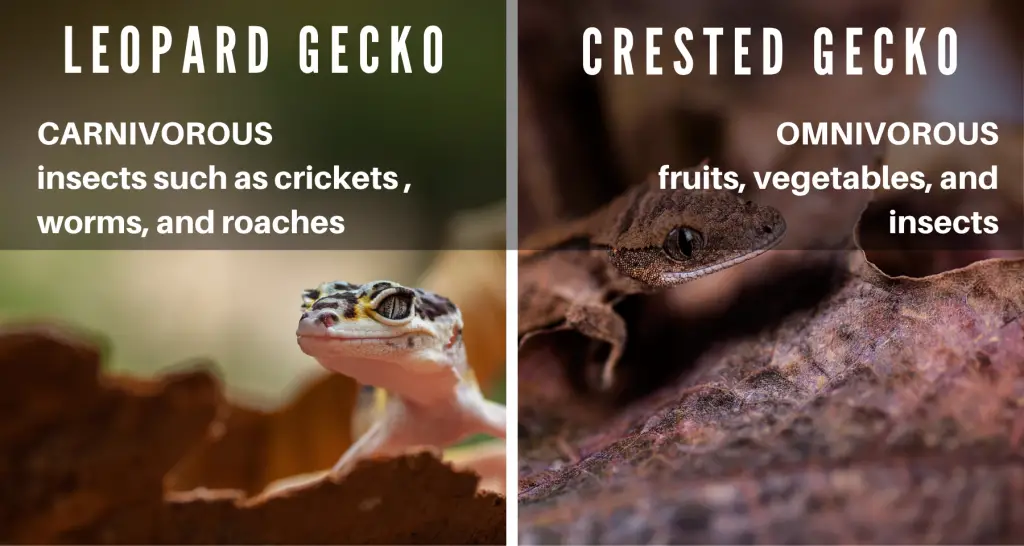
Decided to get one of each in one enclosure?
Are you tempted to get one of each to have the best of both worlds? Forget about that. Both species are territorial to a certain degree, especially the males.
With each species’ contradicting needs, I could not honestly think how enclosing leos and cresties together would ever work out without both suffering and compromising in one way or another.
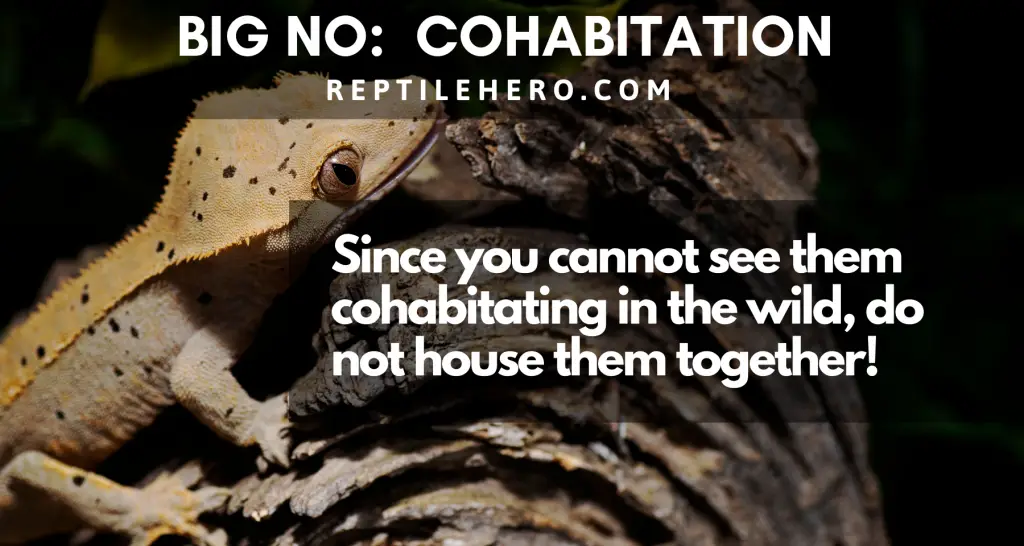
Takeaways
- Leopard and crested geckos differ from their natural habitat. Leos thrive in the arid deserts of Southern Asia while cresties enjoy the forests of New Caledonia.
- Though both share colorful morphs, they have unique physical differences. Leopard geckos have moveable eyelids while crested geckos have tails that do not regrow.
- Despite being domesticated for decades, both leopard and crested geckos exhibit behaviors that are customary to them. Leos tend to have calmer visage while cresties seem more spirited.
- Both leopard and crested geckos have their individual crucial housing needs. Leos need higher temperatures while cresties prefer more humid surroundings.
- While leopard and crested geckos eat live insects, the former cannot tolerate fruits and vegetables.


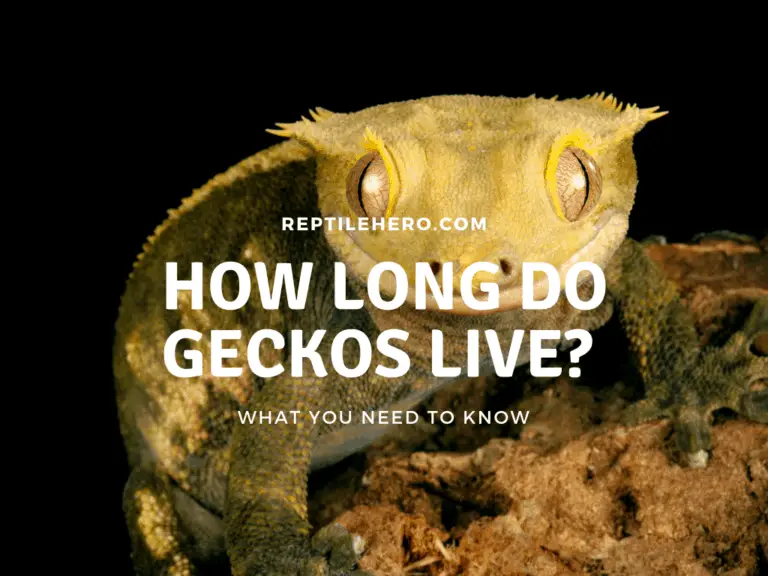
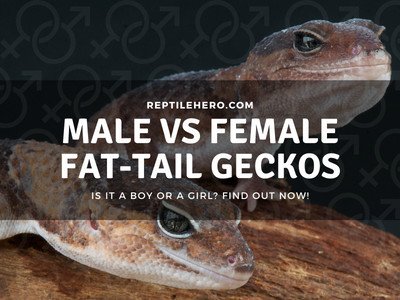

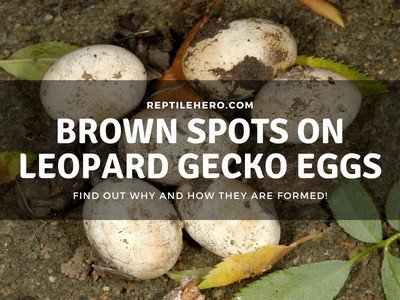
![Gecko Alone While On Vacation? [7 Things To Check]](https://www.reptilehero.com/wp-content/uploads/2022/03/gecko-alone-cc-1-768x614.jpg)